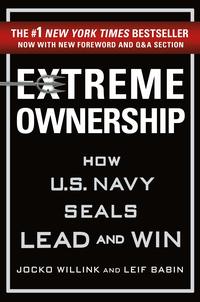Extreme Ownership

On any team, in any organization, all responsibility for success and failure rests with the leader. The leader must own everything in his or her world. There is no one else to blame. The leader must acknowledge mistakes and admit failures, take ownership of them, and develop a plan to win.
The best leaders don’t just take responsibility for their job. They take Extreme Ownership of everything that impacts their mission. This fundamental core concept enables SEAL leaders to lead high-performing teams in extraordinary circumstances and win. But Extreme Ownership isn’t a principle whose application is limited to the battlefield. This concept is the number-one characteristic of any high-performance winning team, in any military unit, organization, sports team or business team in any industry.
“Corporate doesn’t understand what’s going on out here,” said the field manager. “Whatever experience those guys had in the field from years ago, they have long forgotten. They just don’t get what we are dealing with, and their questions and second-guessing prevents me and my team from getting the job done.”
The infamous they.
The Dichotomy of Leadership
A good leader must be:
- confident but not cocky;
- courageous but not foolhardy;
- competitive but a gracious loser;
- attentive to details but not obsessed by them;
- strong but have endurance;
- a leader and follower;
- humble not passive;
- aggressive not overbearing;
- quiet not silent;
- calm but not robotic, logical but not devoid of emotions;
- close with the troops but not so close that one becomes more important than another or more important than the good of the team; not so close that they forget who is in charge.
- able to execute Extreme Ownership, while exercising Decentralized Command.
A good leader has nothing to prove, but everything to prove.
Extreme Ownership: How U.S. Navy Seals Lead and Win, Jocko Willink & Leif Babin.
March 28, 2021 | @ArturoHerrero